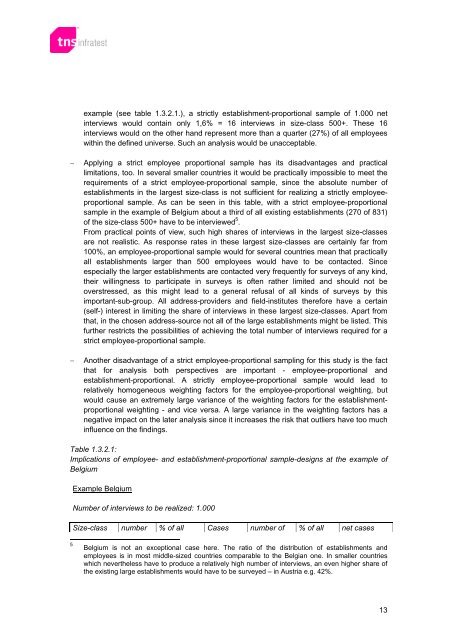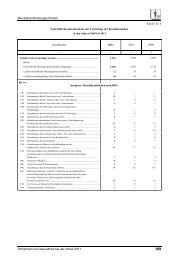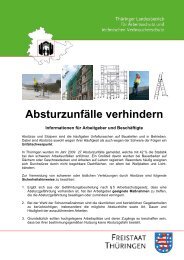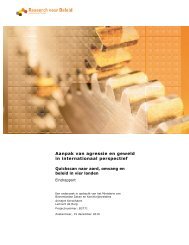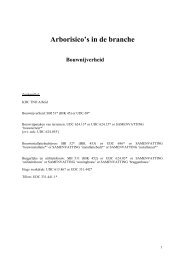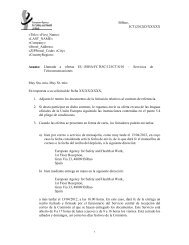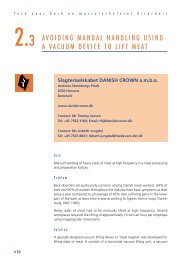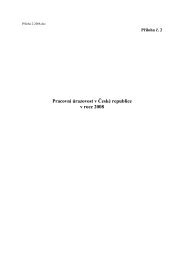ESENER-PSR 2009 - European Agency for Safety and Health at Work
ESENER-PSR 2009 - European Agency for Safety and Health at Work
ESENER-PSR 2009 - European Agency for Safety and Health at Work
You also want an ePaper? Increase the reach of your titles
YUMPU automatically turns print PDFs into web optimized ePapers that Google loves.
example (see table 1.3.2.1.), a strictly establishment-proportional sample of 1.000 net<br />
interviews would contain only 1,6% = 16 interviews in size-class 500+. These 16<br />
interviews would on the other h<strong>and</strong> represent more than a quarter (27%) of all employees<br />
within the defined universe. Such an analysis would be unacceptable.<br />
Applying a strict employee proportional sample has its disadvantages <strong>and</strong> practical<br />
limit<strong>at</strong>ions, too. In several smaller countries it would be practically impossible to meet the<br />
requirements of a strict employee-proportional sample, since the absolute number of<br />
establishments in the largest size-class is not sufficient <strong>for</strong> realizing a strictly employeeproportional<br />
sample. As can be seen in this table, with a strict employee-proportional<br />
sample in the example of Belgium about a third of all existing establishments (270 of 831)<br />
of the size-class 500+ have to be interviewed 5 .<br />
From practical points of view, such high shares of interviews in the largest size-classes<br />
are not realistic. As response r<strong>at</strong>es in these largest size-classes are certainly far from<br />
100%, an employee-proportional sample would <strong>for</strong> several countries mean th<strong>at</strong> practically<br />
all establishments larger than 500 employees would have to be contacted. Since<br />
especially the larger establishments are contacted very frequently <strong>for</strong> surveys of any kind,<br />
their willingness to particip<strong>at</strong>e in surveys is often r<strong>at</strong>her limited <strong>and</strong> should not be<br />
overstressed, as this might lead to a general refusal of all kinds of surveys by this<br />
important-sub-group. All address-providers <strong>and</strong> field-institutes there<strong>for</strong>e have a certain<br />
(self-) interest in limiting the share of interviews in these largest size-classes. Apart from<br />
th<strong>at</strong>, in the chosen address-source not all of the large establishments might be listed. This<br />
further restricts the possibilities of achieving the total number of interviews required <strong>for</strong> a<br />
strict employee-proportional sample.<br />
Another disadvantage of a strict employee-proportional sampling <strong>for</strong> this study is the fact<br />
th<strong>at</strong> <strong>for</strong> analysis both perspectives are important - employee-proportional <strong>and</strong><br />
establishment-proportional. A strictly employee-proportional sample would lead to<br />
rel<strong>at</strong>ively homogeneous weighting factors <strong>for</strong> the employee-proportional weighting, but<br />
would cause an extremely large variance of the weighting factors <strong>for</strong> the establishmentproportional<br />
weighting - <strong>and</strong> vice versa. A large variance in the weighting factors has a<br />
neg<strong>at</strong>ive impact on the l<strong>at</strong>er analysis since it increases the risk th<strong>at</strong> outliers have too much<br />
influence on the findings.<br />
Table 1.3.2.1:<br />
Implic<strong>at</strong>ions of employee- <strong>and</strong> establishment-proportional sample-designs <strong>at</strong> the example of<br />
Belgium<br />
Example Belgium<br />
Number of interviews to be realized: 1.000<br />
Size-class number % of all Cases number of % of all net cases<br />
5 Belgium is not an exceptional case here. The r<strong>at</strong>io of the distribution of establishments <strong>and</strong><br />
employees is in most middle-sized countries comparable to the Belgian one. In smaller countries<br />
which nevertheless have to produce a rel<strong>at</strong>ively high number of interviews, an even higher share of<br />
the existing large establishments would have to be surveyed – in Austria e.g. 42%.<br />
13


